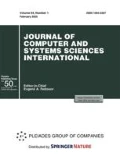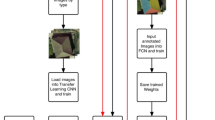Abstract
The height of a building is a basic characteristic needed for analytical services. It can be used to evaluate the population and functional zoning of a region. The analysis of the height structure of urban territories can be useful for understanding the population dynamics. In this paper, a novel method for determining a building’s height from a single-shot Earth remote sensing oblique image is proposed. The height is evaluated by a simulation algorithm that uses the masks of shadows and the visible parts of the walls. The image is segmented using convolutional neural networks that makes it possible to extract the masks of roofs, shadows, and building walls. The segmentation models are integrated into a completely automatic system for mapping buildings and evaluating their heights. The test dataset containing a labeled set of various buildings is described. The proposed method is tested on this dataset, and it demonstrates the mean absolute error of less than 4 meters.






Similar content being viewed by others
REFERENCES
R. B. Irvin and D. M. McKeown, “Methods for exploiting the relationship between buildings and their shadows in aerial imagery,” IEEE Trans. Syst. Man Cybern. 19, 1564–1575 (1989).
A. Ahmad and L. Rabiu, “Generation of three dimensional model of building using photogrammetric technique,” in Proceedings of the IEEE 7th International Colloquium on Signal Processing and its Applications, Penang, Malaysia (IEEE, 2011), pp. 225–231. https://doi.org/10.1109/cspa.2011.5759877
E. P. Baltsavias, “A comparison between photogrammetry and laser scanning,” ISPRS J. Photogramm. Remote Sens. 54, 83–94 (1999). https://doi.org/10.1016/s0924-2716(99)00014-3
A. Comber, M. Umezaki, R. Zhou, et al., “Using shadows in high-resolution imagery to determine building height,” Remote Sens. Lett. 3, 551–556 (2012). https://doi.org/10.1080/01431161.2011.635161
G. Liasis and S. Stavrou, “Satellite images analysis for shadow detection and building height estimation,” ISPRS J. Photogramm. Remote Sens. 119, 437–450 (2016). https://doi.org/10.1016/j.isprsjprs.2016.07.006
N. Kadhim and M. Mourshed, “A shadow-overlapping algorithm for estimating building heights from VHR satellite images,” IEEE Geosci. Remote Sens. Lett. IEEE 15, 8–12 (2017). https://doi.org/10.1109/lgrs.2017.2762424
P. Jaccard, “Etude comparative de la distribution florale dans une portion des alpe’s et du jura,” Bull. Soc. Vaudoise Sci. Naturelles 37, 547–579 (1901). https://doi.org/10.5169/seals-266450
L. Mou and X. X. Zhu, “IM2HEIGHT: Height estimation from single monocular imagery via fully residual convolutional-deconvolutional network,” arXiv: 1802.10249.
G. G. Sebryakov, V. N. Soshnikov, I. S. Kikin, and A. A. Ishutin, “Algorithm for automatic recognition of ground objects in optoelectric images, based on evaluation of feature covariance matrices built for image gradient functions,” Vestn. Komp’yut. Inform. Tekhnol. 109 (7), 14–19 (2013).
Yu. V. Vizil’ter and S. Yu. Zheltov, “The use of projective morphologies for object detection and identification in images,” J. Comput. Syst. Sci. Int. 48, 282 (2009).
G. Novikov, A. Trekin, G. Potapov, et al., “Satellite imagery analysis for operational damage assessment in emergency situations,” Lect. Notes Business Inform. Process. 320, 347–358 (2018). https://doi.org/10.1007/978-3-319-93931-5_25
V. Ignatiev, A. Trekin, V. Lobachev, et al., “Targeted change detection in remote sensing images,” in Proceedings of the SPIE 11th International Conference on Machine Vision ICMV 2018, Germany, Munich, 2018, Proc. SPIE 11041 (2019). https://doi.org/10.1117/12.2523141
E. A. Van, D. Lindenbaum, and T. M. Bacastow, “Spacenet: A remote sensing dataset and challenge series,” arXiv:1807.01232.
Kaggle Inc., DSTL Satellite Imagery Feature Detection Challenge. www.kaggle.com/c/dstl-satellite-imagery-feature-detection/.
F. Rottensteiner, G. Sohn, M. Gerke, et al., ISPRS Semantic Labeling Contest. http://www2.isprs.org/commissions/comm3/wg4/semantic-labeling.html.
E. Maggiori, Y. Tarabalka, G. Charpiat, et al., “Can semantic labeling methods generalize to any city? The inria aerial image labeling benchmark,” in Proceedings of the IEEE International Geoscience and Remote Sensing Symposium IGARSS, Fort Worth, Texas,2017 (IEEE, 2017), pp. 3226–3229. https://doi.org/10.1007/978-3-319-24574-4
OpenStreetMap Contributors, Planet Dump. https://planet.osm.org. https://planet.openstreetmap.org/.
State Corporation – Housing and Utilities Reform Support Fund, Open Data. Housing Reform. www.reformagkh.ru/opendata.
Aeronetlab, Skoltech Open Dataset for Building Height Estimation. https://github.com/aeronetlab/open-datasets.
F. Qi, J. Z. Zhai, and G. Dang, “Building height estimation using Google Earth,” Energy Buildings 118, 123–132 (2016). https://doi.org/10.1016/j.enbuild.2016.02.044
O. Ronneberger, Ph. Fischer, and Th. Brox, “U-net: Convolutional networks for biomedical image segmentation,” in Proceedings of the 2015 International Conference on Medical Image Computing and Computer-Assisted Intervention, Munich, Germany (Springer, 2015), pp. 234–241. https://doi.org/10.1007/978-3-319-24574-4_28
G. Huang, Z. Liu, and M. van der Maaten, “Densely connected convolutional networks,” in Proceedings of the 2017 IEEE International Conference on Computer Vision and Pattern Recognition, Honolulu, HI, USA (IEEE, 2017), pp. 4700–4708. https://doi.org/10.1109/cvpr.2017.243
C. Szegedy, V. Vanhoucke, and S. Ioffe, “Rethinking the inception architecture for computer vision,” in Proceedings of the 2016 International Conference on Computer Vision and Pattern Recognition, Las Vegas, NV (IEEE, 2016), pp. 2818–2826. https://doi.org/10.1109/cvpr.2016.308
C. Szegedy, S. Ioffe, and V. Vanhoucke, “Inception-V4, inception-resnet and the impact of residual connections on learning,” in Proceedings of the 2017 AAAI International Conference on Artificial Intelligence, San Francisco, CA (AAAI Press, 2017), pp. 2818–2826. https://doi.org/10.1109/cvpr.2016.308
K. He, X. Zhang, Sh. Ren, et al., “Deep residual learning for image recognition,” in Proceedings of the 2016 International Conference on Computer Vision and Pattern Recognition, Las Vegas, NV (IEEE, 2016), pp. 770–778. https://doi.org/10.1109/cvpr.2016.90
J. Deng, W. Dong, R. Socher, et al., “Imagenet: A large-scale hierarchical image database,” in Proceedings of the 2009 IEEE International Conference on Computer Vision and Pattern Recognition, Miami, FL (IEEE, 2009), pp. 248–255. https://doi.org/10.1109/cvpr.2009.5206848
V. Iglovikov and A. Shvets, “Ternausnet: U-net with VGG11 encoder pre-trained on imagenet for image segmentation,” arXiv:1801.05746.
A. Odena, V. Dumoulin, and C. Olah, “Deconvolution and checkerboard artifacts,” Distill. 1 (10) (2016); arXiv:1802.10249. https://doi.org/10.23915/distill.00003
N. Weir, D. Lindenbaum, and A. Bastidas, “SpaceNet MVOI: A multi-view overhead imagery dataset,” arXiv:1903.12239.
F. Chollet, Keras. https://keras.io.
D. P. Kingma and J. Ba, “Adam: A method for stochastic optimization,” arXiv:1412.6980.
G. A. Licciardi, A. Villa, M. Dalla, et al., “Retrieval of the height of buildings from WorldView-2 multi-angular imagery using attribute filters and geometric invariant moments,” IEEE J. Sel. Top. Appl. Earth Observ. Remote Sens. 5, 71–79 (2012). https://doi.org/10.1109/jstars.2012.2184269
Funding
This work was supported by the Ministry for Science and Education of the Russian Federation, project no. RFMEFI60719X0312.
Author information
Authors and Affiliations
Corresponding authors
Additional information
Translated by A. Klimontovich
Rights and permissions
About this article
Cite this article
Trekin, A.N., Ignatiev, V.Y. & Yakubovskii, P.Y. Deep Neural Networks for Determining the Parameters of Buildings from Single-Shot Satellite Imagery. J. Comput. Syst. Sci. Int. 59, 755–767 (2020). https://doi.org/10.1134/S106423072005007X
Received:
Revised:
Accepted:
Published:
Issue Date:
DOI: https://doi.org/10.1134/S106423072005007X




